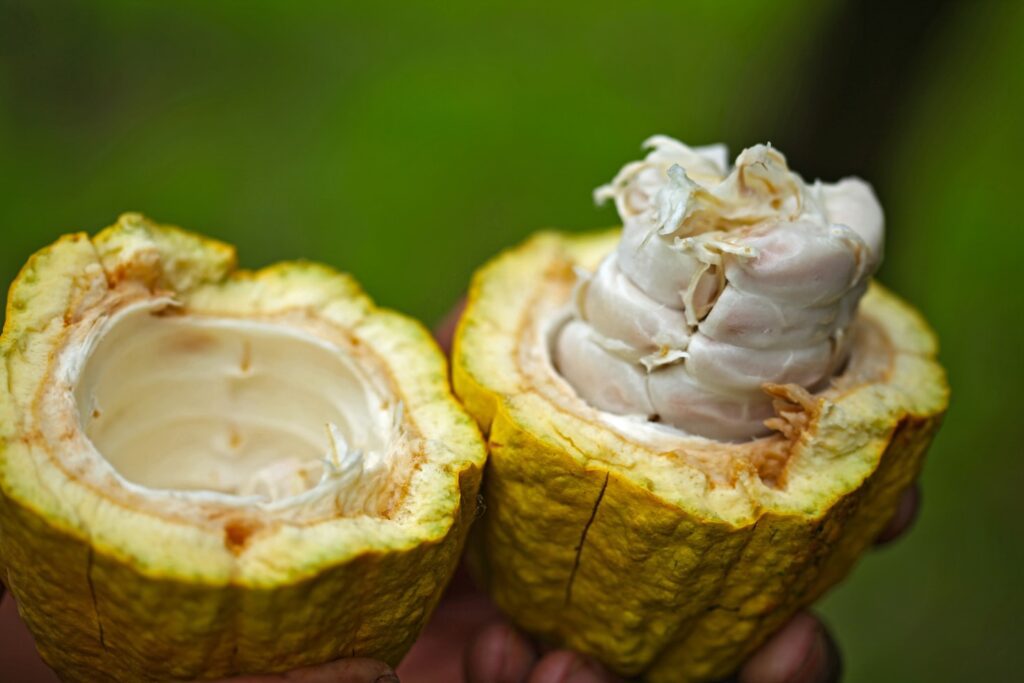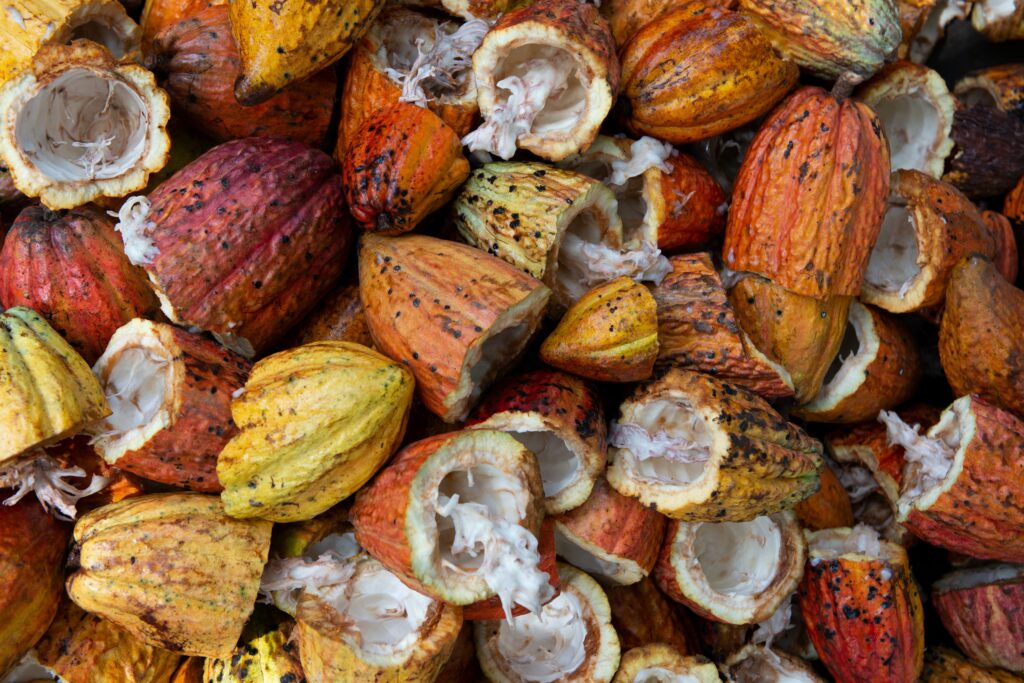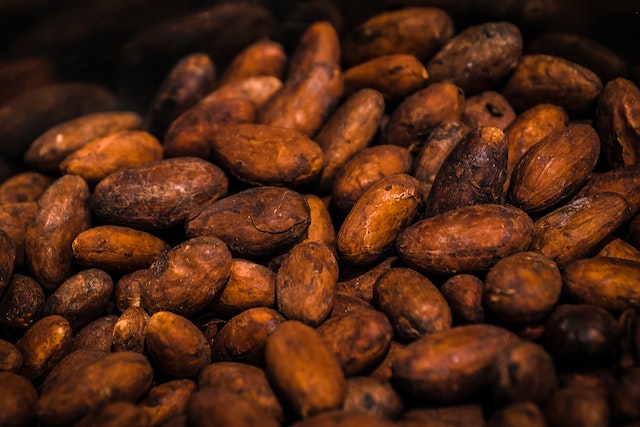
Boocha, Delicious Cacao Pulp Juice Kombucha
January 16, 2023
Benefits of Hot Cocoa for Your Health: Heart, Brain, Skin, and More
February 15, 2023The Untapped Power of Cocoa Waste
Cacao By-Products
A third of the world’s food ends up as waste during production processes, and among the leading industries in this waste-generation is the cocoa industry. Although every part of the cacao fruit has other potential uses, only cacao beans are usually used to make cocoa products like chocolate, cocoa powder, and cocoa butter. This leaves out the pod husk, bean shells, and pulp, to end up as waste from chocolate production.
But these agro-industrial cacao by-products present a valuable source of nutrients, biofuel, and income.
In this article, we outline these cacao by-products and their potential health, economic, and environmental benefits. But first, let’s look at why waste-generation is a problem in the cocoa supply chain.
Why Cacao By-Products Waste is a Problem
As one of the most cultivated cash crops in the world, Cocoa is a major source of revenue for cocoa farmers, especially for the West African farmers who push out over 70% of global supply. The vast amount of cacao by-product waste generated along the production and supply chain is a huge loss of potential income for the supply chain, exacerbating food insecurity and poverty in poorer regions.
Besides the loss of economic value to generated waste is the environmental pollution. Most cocoa by-product waste are abandoned on the plantations or stored in fields.
The waste decomposition attracts flies and other insects that are harmful to the cacao tree. For example, decomposition residues are a potential source of pathogenic microorganisms like the fungi that cause the black pod disease. This disease alone causes annual global yield loss of 20 – 30% worldwide, resulting in huge financial losses that are most felt by local farmers.
With the potential for economic, health, and environmental benefits, the ideas of generating wealth from cacao by-products waste and recyclable materials are vital in developing a more sustainable industry and healthy world.
Cacao By-Products and How They Can Be Utilized
1. Cacao Pulp

Cacao bean covered in pulp in opened pod
Cacao pulp is the mucilage that surrounds the cacao bean. It makes up 5-7 % of the fresh cocoa weight. After cacao beans are removed from the ripe pod, the pulp is usually left to ferment alongside the beans. During fermentation, the pulp is broken down by bacteria into a liquid that is then drained out and thrown away.
There are two main reasons why cacao pulp usually wastes away after harvesting the beans. One, the sugars in the pulp help create a suitable environment for the growth of the bacteria needed for the fermentation of the cacao beans. Two, to separate the pulp from the beans is a time-consuming process which, until now, farmers were not willing to indulge in.
Fortunately, the trend is changing, and this very nutritious pulp can be turned into a raw material for cacao pulp juice, jam, and marmalade.
Cacao pulp juice, particularly, represents a great way for farmers to diversify their income as its production adds value to one of the by-products that make up a good part of the cacao pods. The pulp is fermented, filtered, and pasteurised to give an exotic flavoured sweet-sour juice that so far has met much success with consumers. Cacao pulp juice is on the rise to become one of the most sought-after beverages in a world with more health-conscious consumers.
Related: Boocha, the Cacao Pulp Juice Kombucha.
2. Cacao Pod Husk

Cacao pod husks with beans removed
The cacao pod husk is the part left over after the harvest of cacao beans. For each ton of cacao beans produced, 10 tonnes of pod husks are discarded as waste. The husk makes up to 70-80% of the weight of the cacao fruit. This part of the plant comprises a thick and rough outer layer that protects the cacao beans from external aggressions. The inner part of the husk is made up of 3 layers that hold the cacao beans in place.
This cacao by-product is a rich source of protein, fibres, potassium, and other minerals. Pod husks can be transformed into high-value products., such as raw materials to produce agrochemicals, biomaterials, biofuels, and organic acids.
Below are several ways cacao pod husks can be transformed into high-value products:
i) Cacao pod husks constitute an alternative animal feed source. Treated powder from pod husks can be used as ingredient for poultry, pigs and sheep feed. The pod husks can also be fermented using oyster mushroom and added to broiler finisher feed. Fresh cacao pods husks can even be fed directly to pigs.
ii) Cacao pod husks are a good source of dietary fiber with a high content of water-soluble pectins, bioactive compounds which can be incorporated into food. A good example is the transformation of cacao pod husk into flour. In a 2021 study, cacao pod husk flour was used as a starch replacement in Frankfurter sausage. This study revealed cacao pod husks could be used as a new ingredient to ameliorate the technological parameters, functional characteristics, and stability of meat products like sausage.
iii) Cacao pod ash has been commonly used in West African countries to produce african black soap which today is sold worldwide. Cacao pod husks when sun-dried and burned produce an ash comprising 40% of potassium hydroxide or potash. This serves as a catalyst for saponification when added to oils to produce soap.
iv) Cacao pod ash can also be used to manufacture fertilizers. The potassium found in the ash can be mixed with starch and processed into pellets which can be easily used to fertilize the soil.
v) Cacao pod husks can serve as a catalyst in the production of biofuel. In a 2017 study, cacao pod husks transformed into activated charcoal was successfully used as a catalyst in the production of biodiesel from waste cooking oil. In a 2016 study, the lipase enzyme extracted from cacao pod husks was successfully used as catalyst in the production of biofuel from jatropha curcas oil and ethanol.
3. Cacao Shell
The cacao shell is the coat that is removed from the cacao bean or seeds before or after they are roasted. It is a brown and crispy fibrous husk with a nice chocolate-like scent.
This part of the bean is rich in fiber, protein and antioxidants, making it of interest to the food industry. It can be used in baking and confectionary products, as well as in low calorie dietetic and fiber-rich products.
Cacao shells show the most potential as an ingredient for the manufacture of animal feed. Just like cacao pod husks, the shell represents an alternative animal feed source. Researchers have pointed out that cacao shell can be an energy substitute to maize in pig feed.
Cacao shells also show a potential in the development of biofuel. Ethanol obtained from plant biomass composed of cellulose, hemicellulose, and lignin are seen as an alternative to fossil fuel. When broken down and fermented, the sugars present in cacao shells proved to be an excellent source of ethanol.
Cacao shells can equally be transformed into activated charcoal and used as cheap adsorbent to entrap pollutants like industrial dyes, heavy metal ions, and gases.
4. Cacao Nibs
Cacao nibs are the bits of cacao bean meat left over after cacao beans have been fermented and dried. These have an intense chocolate flavor and a bitter taste. They are mostly used in the culinary world as an ingredient to add flavor to dishes. They can be added raw to foods such as cereals, smoothies, granola bars and sauces, or sold as a stand-alone candy.
5. Cacao Sweatings
Cacao sweatings refers to the liquid produced during the fermentation of cacao beans. This liquid comes from the breakdown of pectin in the cacao pulp surrounding the beans. The fermentation of the sugars present in cacao sweatings produces alcohol that can be used in the manufacture of alcoholic drinks like gin and brandy. Cacao sweatings can also be used in the production of vinegar and wine.
How Bantu Chocolate Reduces Waste from Chocolate Production
Utilizing cacao by-products to reduce waste from chocolate production is a huge step towards more sustainable cocoa farming and development. That is why at Bantu Chocolate, we place sustainability at the fore of cacao pulp juice production processes.
The cacao beans on our farm in Cameroon are grown with the utmost respect for sustainable cocoa farming practices. Our 100% cacao pulp juice is produced using a solar-powered sterilisation system that respects the environment. Our goal is to reinvent the use of cacao to help people, businesses, and our planet thrive.
References:
Cocoa and Its By-Products: Identification and Utilization https://link.springer.com/chapter/10.1007/978-1-61779-803-0_3
What Are Cacao Nibs? https://www.thespruceeats.com/cacao-nibs-overview-3371731
Exploration of Cocoa (Theobroma cacao) By-Products as Valuable Potential Resources in Livestock Feeds and Feeding Systems https://www.intechopen.com/chapters/68088
“Unlocking the pulp potential”: Nestle recipe replaces refined sugar-with-cocoa-pulp https://www.foodnavigator.com/Article/2019/07/16/Unlocking-the-pulp-potential-Nestle-recipe-replaces-refined-sugar-with-cocoa-pulp
List of cocoa by-products and their utilization https://foodtechpathshala.com/utilisation-of-cocoa-by-products/“
Cocoa pod husks as potential sources of renewable high-value-added products: A review of current valorizations and future prospects https://bioresources.cnr.ncsu.edu/resources/cocoa-pod-husks-as-potential-sources-of-renewable-high-value-added-products-a-review-of-current-valorizations-and-future-prospects/
Cocoa Shell: A By-Product with Great Potential for Wide Application https://www.ncbi.nlm.nih.gov/pmc/articles/PMC6099939/
Large Genetic Diversity Unveiled By Analyzing Chuncho Pulp https://beantobarworld.com/research-1/2019/7/2/fine-flavour-cacao-linked-to-genetics-amp-pulp-flavour-in-chuncho-cacao-from-cusco-peru
Cacao Pod Husk Flour as an Ingredient for Reformulating Frankfurters: Effects on Quality Properties https://www.mdpi.com/2304-8158/10/6/1243/htm
Cocoa pod husk: A new source of CLEA-lipase for preparation of low-cost biodiesel: An optimized process https://www.sciencedirect.com/science/article/abs/pii/S0168165616302711
.
Chocolate Extinction: Fact vs. Fiction + What Chocolate Lovers Can Do
Chocolate ExtinctionFact vs. Fiction, What Consumers Can Do Share On Facebook Twitter Email Is the world really running out of chocolate? Not really. Currently the global […]
Corporate Chocolate Gifting Ideas to Appreciate Employees and Delight Clients
Corporate Chocolate GiftingHow to Appreciate Employees & Delight Clients Share On Facebook Twitter Email When it comes to corporate gifting, a one-gift-fits-all approach just doesn't cut […]
Cacao Supper Club at Home: Guide to Tasting Chocolate, Cacao Tea, and Pulp Juice
Cacao Supper Club at HomeGuide to Tasting Chocolate, Cacao Tea, and Pulp Juice Share On Facebook Twitter Email Imagine gathering around the table with a few […]






